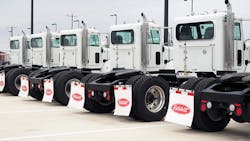No matter the cost of fuel, new trucks can still offer savings
Fleets fret a good deal about the cost of fuel, and understandably so — it's one of their biggest and most variable business costs. But regardless of whether diesel prices stay low or even were to spike suddenly, new power units can still save you money.
So says Fort Lauderdale, FL-based truck leasing and business analytics firm Fleet Advantage. "Even though the price of fuel could go up significantly, if it were to do that, a new truck really offsets it because it brings your maintenance costs down to brand-new truck first-year maintenance," contends Mike Spence, the company's senior vice president of fleet services.
Most analysts' and consultants' predictions for the price of oil this year don't herald a fast, dramatic climb upward, to be sure, and neither does Fleet Advantage. "We don't anticipate that diesel is going to go from about $2.40/gal. now to $3.40/gal. anytime soon, but I think we've discovered that the world economy doesn't work very well on $35/bbl crude oil prices," Spence says.
Even so, he walks through just such a scenario, particularly given new, more efficient model year (MY) 2017 trucks being produced. If a fleet is running trucks 100,000 mi. per year and getting about 6.8 mpg, that's approximately 14,700 gal. of fuel needed and thus an additional cost of around $14,700 if fuel were to bounce upward suddenly by $1.00/gal. Once you roll in maintenance costs as well, though, moving from a 2011 day cab to a 2017 day cab, total savings due to better fuel efficiency and less maintenance work out to about $19,700.
"So regardless of what happens with the price of fuel, there's big savings in changing your asset model and moving out of these older vehicles that are quite expensive to run and into a new 2017 truck, which kind of resets your maintenance costs per mile," Spence tells Fleet Owner.
Fleet Advantage analyzes data from its customers' maintenance records and the trucking industry at large. The company calculates for fuel savings with diesel at $3.00/gal. and $4.00/gal. depending on if a fleet is running model year 2011-2017 trucks as well as total cost of ownership of that range of trucks at the two fuel price points. For example, with diesel at $3.00/gal., moving from a 2011 day cab to a 2017 day cab would save $6,425 in fuel costs alone, Fleet Advantage calculates; at $4.00/gal. for diesel, that same 2011-to-2017 truck replacement would save $8,566 in fuel costs.
Fuel savings
@ $3.00/gal. for diesel
Current vs. MY 2017 day cab
Fuel savings
@ $4.00/gal. for diesel
Current vs. MY 2017 day cab
Current model year
Current MY cost
MY 2017 cost
Approx. MY 2017 savings
Current model year
Current MY cost
MY 2017 cost
Approx. MY 2017 savings
2011
$46,802
$40,377
$6,425
2011
$62,402
$53,836
$8,566
2012
$45,662
$40,377
$5,285
2012
$60,883
$53,836
$7,047
2013
$44,577
$40,377
$4,200
2013
$59,435
$53,836
$5,599
2014
$43,478
$40,377
$3,101
2014
$57,971
$53,836
$4,135
2015
$42,373
$40,377
$1,996
2015
$56,497
$53,836
$2,661
Total cost of ownership
@ $3.00/gal. for diesel
Current vs. MY 2017 day cab
Total cost of ownership
@ $4.00/gal. for diesel
Current vs. MY 2017 day cab
Current model year
Current MY cost
MY 2017 cost
Approx. MY 2017 savings
Current model year
Current MY cost
MY 2017 cost
Approx. MY 2017 savings
2011
$80,133
$60,433
$19,700
2011
$95,713
$73,885
$21,828
2012
$75,092
$60,433
$14,659
2012
$90,313
$73,885
$16,428
2013
$72,080
$60,433
$11,647
2013
$86,938
$73,885
$13,053
2014
$70,045
$60,433
$9,612
2014
$84,538
$73,885
$10,653
2015
$66,577
$60,433
$6,144
2015
$80,701
$73,885
$6,816
Source: Fleet Advantage
"The tables at the bottom tell the real tale, though," Spence says. "Rather than just looking at fuel, you're looking at the total cost to run that vehicle." Of course, there's less of a total cost reduction in going from a newer model year such as 2014 or 2015 to a 2017 truck. Still, replacing a MY 2015 day cab with a MY 2017 one will save about $6,144 in total ownership costs with diesel at $3.00/gal. or $6,816 with diesel at $4.00/gal.
"For every dime the cost of fuel goes up per gallon, that ends up costing about $1,400 when you're running 100,000 mi./year and you're up around 6.8 or 6.9 mpg," says Spence, noting that there's a compound annual growth of about 2.5% fuel economy per model year for heavy trucks. "The big savings in new technology is the reduction you see in running costs," he explains, "and that technology is rolled in over a shorter period of time."
About the Author
Aaron Marsh
Aaron Marsh is a former senior editor of FleetOwner, who wrote for the publication from 2015 to 2019.
